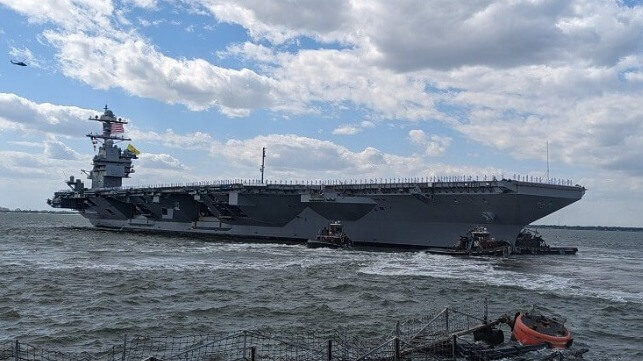Six Years After Delivery, USS Ford Departs on First Full Deployment

The first-in-class carrier USS Gerald R. Ford is under way at last for her first full deployment under the control of a regional combatant commander, marking a major milestone in her six-year journey from delivery to operation.
"This strike group is the cornerstone of our Navy's forward operations, capable of meeting any tasking provided by regional combatant commanders to ensure peace and stability at sea," said Rear Adm. Greg Huffman, Commander, Carrier Strike Group 12. "Our presence at sea throughout the deployment will provide reassurance to our partners and allies that sea lanes will remain open."
"The moment we've all been training for... USS Gerald R. Ford deploys. #USSGeraldRFord #IntegrityAtTheHelm #ForgedByTheSea
— USS Gerald R. Ford (CVN 78) (@Warship_78) May 3, 2023
.#aircraft #carrier #aircraftcarrier #USNavy #navy #deployment #military #Atlantic #ship #ocean #Sailor #cvn78 @USFleetForces @US2ndFleet @flynavy @USNavy pic.twitter.com/1FLrofcrbg
The deployment marks the ship's first combat deployment, following a trial-scale two month deployment in the North Atlantic earlier this year. That voyage was a "service-retained" deployment to test out the ship and practice coordinating with NATO-allied navies, and Ford remained under the Navy's command throughout.
On this deployment, Ford is expected to transit to the Mediterranean and take up the presence mission that the Navy has maintained in the area since the beginning of the invasion of Ukraine. The last carrier on watch in the region, USS George H.W. Bush, recently returned to Norfolk.
Ford will transit with four surface escorts, the cruiser USS Normandy and the destroyers USS Ramage, USS McFaul and USS Thomas Hudner.
Ford departs without the next-gen F-35C stealth fighter, which made its first operational deployment overseas aboard USS Carl Vinson in 2021. Like the rest of the Navy's carriers, Ford will require modifications to accommodate the F-35, and these upgrades are scheduled for 2025.

that matters most
Get the latest maritime news delivered to your inbox daily.
Ford's first full deployment has been a long time coming. Her advanced launch and recovery gear and her weapons elevators are all electromagnetic, a technological departure from the previous Nimitz-class carriers. These systems were installed in the first-in-class vessel without first achieving full maturation on shore. The Navy accepted delivery of Ford in 2017, but the post-delivery installation and commissioning work took more than four years, adding to the vessel's unprecedented $13 billion acquisition cost. As recently as this January, the Pentagon's testing watchdog warned that there may still be work to do.
"The reliability of CVN 78 catapults, arresting gear, and jet blast deflectors (JBDs) continues to have an adverse effect on sortie generation and flight operations efficiency," noted DOT&E in an annual report released in mid-January. "The ongoing reliability problems with these critical subsystems remains the primary risk to the successful completion of CVN 78 [initial operational testing and evaluation]."
